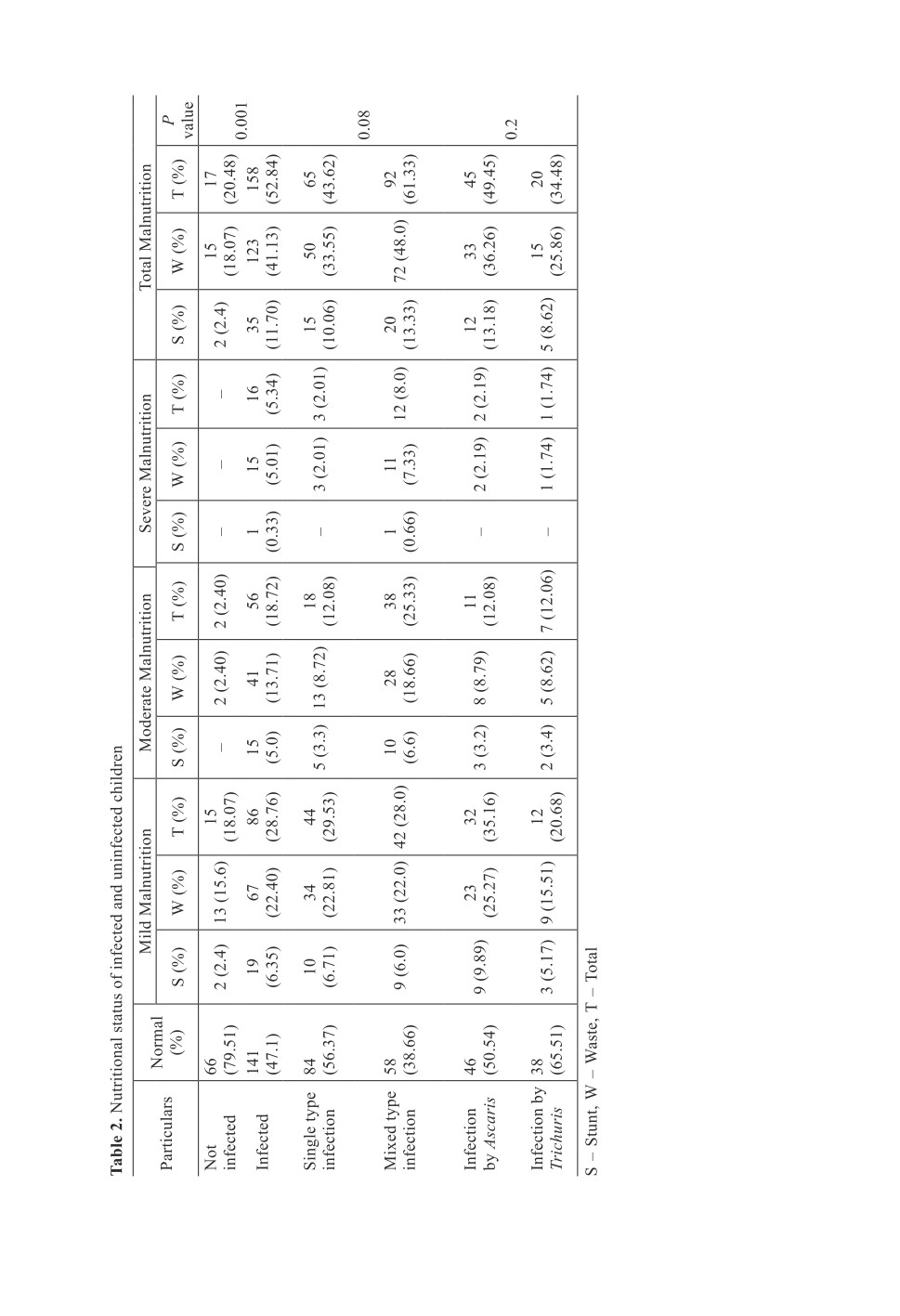ПАРАЗИТОЛОГИЯ, 2020, том 54, № 3, с. 198-204.
Удк 616:576.8
Soil Transmitted Helminth infection and its effect
on nutritional status of children in Kashmir
© 2020 Showkat Ahmad Wani*
Department of Zoology, S. P. College Campus, Cluster University,
Srinagar, 190001 India
*e-mail: drshowkat78@gmail.com
Phone: 09596168675, 07006314731
Received 26.03.2020
Received in revised form 19.05.2020
Accepted 22.05.2020
The high prevalence of intestinal helminth infections among children living in developing countries
impairs growth in these populations. Present study was aimed at comparing the nutritional status of
children infected by soil-transmitted helminths (STH) with that of uninfected children. Stool samples
and anthropometric measurements were taken from 382 children. Stool samples were processed by
using both simple smear and zinc sulphate concentration methods. Nutritional status was assessed
by Waterlow classification. Of the 382 children surveyed, 78.27 % were infected with either Ascaris
lumbricoides or Trichuris trichiura, or both. Children infected with STH were found to be more
malnourished than uninfected children. The present study concludes that soil-transmitted helminths are
abundant among school children of Kashmir valley, with negative impact on their nutritional status.
Keywords: Children, Nutrition, Helminth, Nematode, Kashmir
DOI: 10.31857/S1234567806030025
Soil-transmitted helminth infection is a major factor predisposing to poor nutritional
status among children of low socioeconomic status in developing countries. However, studies
on the impact of soil-transmitted helminth infection on nutritional status are limited (Hall,
1993). Furthermore, most studies on the prevalence of helminth infections focus on preschool
children (De Silva et al., 1994). It is also important to determine the prevalence of helminth
infections in older children and the effect of helminth infections on their nutritional status.
This paper presents data comparing the prevalence of soil-transmitted helminth infections
in children of Kashmir valley and the effect of these infections on their nutritional status.
Material and Methods
Kashmir valley, situated at an altitude of 6000 feet, constitutes the major portion of Jammu and
Kashmir State India, consisting of 10 districts, namely, Annantnag, Kulgam, Shopian, Baramulla,
198
Ganderbal, Bandipora, Budgam, Kupwara, Pulwama, and Srinagar with about 46 Tehsils and about
50 towns. The study was carried out in all the 10 districts. This study was conducted from October
2016 to March 2017. Official meetings with the personnel from health services, city councils and
schools, as well as parents and school children from the study sites, were carried out in order to
explain the protocol of the study. In total 382 children, 219 male and 163 female aged 5-15 yrs.
(9.2 ± 2.3) without disabilities and not receiving antiparasitic treatment, were included in the study.
Initially 480 children were accepted to participate but 98 were rejected during the study because
they had contaminated faecal samples. Written consents were required from both parents in order for
the children to participate. Children requiring medical assistance were properly treated or referred to
medical specialist. The children’s ages were obtained through school records.
Stool examination
Fresh morning stool samples were collected in nylon containers containing 10 ml of 10 %
formaldehyde. The containers were labeled, and immediately transported to the parasitology laboratory,
Department of Zoology, S. P. College campus, Cluster University of Srinagar, for further processing.
The stool specimens were processed using direct smear and zinc sulphate concentration techniques.
Assessment of nutritional status
To study whether there is any relation between the helminth infection and the malnutrition in
the children, nutritional status of the infected and normal children was estimated by using Waterlow
classification.
Waterlow’s Classification
When a childʼs age is known, measurement of weight enables almost instant monitoring of growth.
Measurements of height assess the effect of nutritional status on long-term growth (Waterlow et al.,
1977).
Waterlowʼs classification defines two groups for protein energy malnutrition.
1. Malnutrition with retarded growth, in which a drop in height/age ratio points to chronic condi-
tion - shortness or stunting.
2. Malnutrition with low weight for a normal height, in which the weight for height ratio is
indicative of an acute condition of rapid weight loss or wasting.
This combination of indicators makes it possible to label and classify children with reference to
two poles: children with insufficient but well-proportioned growth and those with a normal height
but who are wasted.
Interpretation of indications (Table 1)
Weight/Height =
Weight of the child
× 100
Weight of the normal child at same height
Height/Age =
Height of the child
× 100
Height of the normal child at same age
Weight in children was measured in kilograms to the nearest decimal point, using a spring balance.
Height was measured in centimeters to the nearest decimal point, using a measuring tape fixed to a wall.
Table 1. Different categories of children with relation to nutritional status
Nutritional status
Stunting, % age of height/age
Wasting, % age of weight/height
Normal
> 95
>90
Mildly impaired
87.5-95
80-90
Moderately impaired
80-87.5
70-80
199
Data entry and analysis
A computer program (SPSS 10.05 for windows; SPSS Inc., Chicago, Illinois, USA) was used for
data analysis. The chi-square test was used to associate risk factors with infection status. Differences
were considered significant when P values of less than 0.05 were obtained.
Results
Among 382 children subjected to stool examination, 299 (78.27 %) were infected with
either Ascaris lumbricoides or Trichuris trichiura, or both. Single and mixed type infections
were observed almost in equal proportions. 149 (39.0 %) children were infected with a single
type of helminth: Ascaris lumbricoides was found in 91 (23.82 %) and Trichuris trichiura in
58 (15.18 %) children. Mixed type infection by Ascaris lumbricoides and Trichuris trichiura
was observed in 150 (39.26 %) children.
In the present study, nutritional status of the infected and uninfected children was
observed (Table 2). It was found that infected children were more prone to malnutrition (158,
52.84 %) than uninfected children (17. 20.48 %) [P<0.05]. Children infected with multiple
types of helminths were found to be more malnourished (92) than children infected with
a single type helminth (65). Ascaris lumbricoides is the main helminth responsible for
causing malnutrition, when present as a single infecting parasite.
Discussion
The present study found a prevalence of 78.27 % for soil-transmitted helminth infections.
These figures, when compared with studies conducted in other parts of the world, show
that Kashmir valley is one of the most hyper-endemic regions for intestinal helminthiasis.
For example, studies conducted on the frequency distribution of gastrointestinal helminths
by Bundy et al. (1988) showed high overall prevalence of 62 % among the urban slum
children of Malaysia. Rodriguez et al. (2000) reported high prevalence of 72 % among
the school children studying in a public institution in Maracaibo, Venezuela. Legesse and
Erko (2004) also noted the high prevalence of 88.2 % among the school children in rural
Ethopia, while Kabatereine et al. (2001) reported an overall prevalence of 56 % among the
school children of south Uganda.
The high prevalence of soil-transmitted helminth infections is probably a consequence
of a low standard of living, poor sanitation, lack of personal hygiene, traditional methods of
agriculture, indiscriminate defecation, the use of night soil as fertilizers and other occupational
work.
Malnutrition was found to be prevalent in the children of Kashmir valley, but it was found
to be more prevalent in children infected by gastrointestinal helminths than in uninfected
children. Further, it was also observed that mixed type infection was responsible for causing
more malnutrition than single type infection. These figures, when compared to other parts
of India (Table 3), show that in Kashmir valley malnutrition is highly prevalent (Ghosh,
Shah, 2004) and needs early attention of medical practitioners, social scientists, economists,
governmental and non-governmental organizations. The reasons behind malnutrition are
200
many, but from present study, it was clear that helminthiasis was one important factor
responsible for malnutrition in already nutritionally compromised children. Sivakumar and
Reddy (1975) showed that ascariasis causes malabsorption of vitamin A; abnormal fat and
increased intestinal transit time, which ultimately leads to malnutrition. Cooper and Bundy
(1988) estimated that approximately 10 % of young children living in conditions appropriate
for hyperendemic geohelminthic transmission could have growth retardation. Gupta (1990)
showed that ascariasis contributes significantly to malnutrition in communities where these
conditions coexist.
Table 3. Prevalence of malnutrition in different Indian Cities (Source: Ghosh, Shah, 2004)
City (Year)
Number
Classification
Prevalence, %
63
Vadodra (2002)
3157
IAP
Grade I - 41
Grade II - 20
Grade III - 2
26
Delhi (2001)
150
IAP
Grade I - 11
Grade II - 9
Grade III - 6
Chronic Energy Deficiency - 51
Varanasi (2001)
70
WHO
Stunt - 10
Chandigarh (2000)
1400
IAP
67
Under weight - 58
Delhi (1997)
630
WHO
Stunted - 53
Wasted - 23
Under weight - 68
Luckhnow
1061
WHO
Stunt - 63
Wasted - 26
60
Srinagar (1997)
584
IAP
Grade I - 33
Grade II - 21
Grade III - 6
51
Calcutta (1994)
1280
IAP
Grade I - 28
Grade II - 17
Grade III - 7
63
Bhopal (1992)
1000
IAP
Grade I - 41
Grade II - 15
Grade III - 2
92
Calcutta (1989)
601
Gomez and WHO
Grade I - 40
Grade II - 44
Grade III - 9
Stunt - 81
Wasted - 9
202
Oberhelman et al. (1998) revealed a correlation between intestinal parasitosis and
malnutrition: he found intestinal parasites among children with low WFA (weight for age)
(48.5 %) versus those with normal WFA (38.5 %). The presence of Ascaris or Trichuris in
the stool was associated with low WFA in the overall group. Differences in the prevalence of
Trichuris by nutritional status were especially striking, with Trichuris eggs present in 9.9 %
of all children with low WFA and in 2.8% of all children with a normal WFA (P=0.00008).
Sugunam et al. (1996) also showed that intestinal parasitic infestations contribute significantly
to poor growth and malnutrition in children. Stephenson (1999) established that the high
prevalence of infections, mostly gut helminth infections among children living in poor areas,
impairs linear growth by affecting nutritional status. Hughes et al. (2004) showed that children
with helminthiasis and anaemia were found to be 8.7 times more likely to be stunted and
4.3 times more likely to be underweight than non anaemic and non-infected children. Other
studies have described how even mild and moderate chronic helminth infection and anaemia
impair the physical and mental development in children (Nokes et al., 1992; Hutchinson et
al., 1997; Dickson et al., 2000). Reduced food intake, impaired digestion, malabsorption and
poor growth are frequently observed in children suffering from ascariasis and trichuriasis
(Crompton, Nesheim, 2002).
From the above discussion it is clear that children in communities with rampant intestinal
helminth infections are at more risk of becoming malnourished than in those where prevalence
of helminth infections is low.
Acknowledgements
I am thankful to all the children, their parents and teachers for their cooperation.
References
Bundy D.A.P., Kan S.P., Rose R. 1988. Age related prevalence, intensity and frequency distribution of gastrointestinal
helminth infections in urban slum children from Kaulalumpur Malaysia. Transactions of the Royal Society
of Tropical Medicine and Hygiene 82 (2): 289-294.
Cooper E.S., Bundy D.A.P. 1988. Trichuris is not trivial. Parasitology Today 4 (11): 301-306.
Crompton D.W.T., Nesheim M.C. 2002. Nutritional impact of intestinal helminthiasis during the human life cycle.
Annual Review of Nutrition 22: 35-59.
De Silva N.R., De Silva H.J., Jayapani V.P.P. 1994. Intestinal parasitosis in Kandy area, Sri Lanka. Southeast Asian
Journal of Tropical Medicine and Public Health 25 (3): 439-473.
Dickson R., Awasthi S., Williamson P., Demellweek C., Garner P. 2000. Effect of treatment for intestinal helminth
infections on growth and cognitive performance in children: systemic review of randomized triala. BMJ
320: 1697-1701.
Ghosh S., Shah D. 2004. Nutritional problems in urban slum children. Indian Pediatrics 41 (1): 682-696.
Gupta M.C. 1990. Effect of Ascariasis upon nutritional status of children. Journal of Tropical Pediatrics 36 (4):
189-191.
Hall A. 1993. Intestinal parasitic worms and the growth of children. Transactions of Royal Society of Tropical
Medicine and Hygiene 87 (3): 241-242.
Hughes R.G., Sharp D.S., Hughes M.C., Akoula S., Heinsbroek P., Schulz D., Palmer K., Cavelli-sforza T., Galea
G. 2004. Environmental influences on helminthiasis and nutritional status among pacific school children.
International Journal of Environmental Health Research 14 (3): 163-177.
Hutchinson S.E., Powell C.A., Walker S.P., Chang S.M., Grantham-McGregor S.M. 1997. Nutrition, anemia,
geohelminth infection and school achievement in rural Jamaican primary school children. European Journal
of Clinical Nutrition 51: 729-735.
203
Kabatereine N.B., Tukahebwa E.M., Brooker S., Alderman H., Hall A. 2001. Epidemiology of intestinal helminth
infestations among school going children in southern Uganda. East African Medical Journal 78 (6): 283-286.
Legesse M., Erko B. 2004. Prevalence of intestinal parasites among school children in a rural area close to the
South east of Lake Langano, Ethiopia. The Ethiopian Journal of Health Development 18 (2): 116-120.
Nokes C., Grantham-McGregor S.M., Sawyer A.W., Robinson B.A., Bundy D.A.P. 1992. Moderate to heavy
infections of Trichuris trichiura affect cognitive functions in Jamaican school children. Parasitology 104
(3): 539-547.
Oberhelman R.A., Guerrero E.S., Fernandez M.L., Silio M., Mercado D., Comisky N., Ihenacho G., Mera R. 1998.
Correlations between intestinal parasitism, physical growth and psychomotor development among infants and
children from rural Nicaragua. The American Journal of Tropical Medicine and Hygiene 58 (4): 470-475.
Rodriguez Z.R., Lozano C.G., Diaz I., Cheng R., Rucson G. 2000. Intestinal parasites in school children at a public
institution in Maracaibo municipality, Venezuela. Investigacion Clinica 41 (1): 37-57.
Sivakumar B., Reddy V. 1975. Absorption of Vitamin A in children with Ascariasis. The Journal of Tropical
Medicine and Hygiene 78 (5): 114-115.
Stephensen C.B. 1999. Burden of infection on growth failure. The Journal of Nutrition 129 (2): S534-S538.
Sugunam A.P., Mushekar M.V., Sehgal S.C. 1996. Intestinal parasitic infestations among different population groups
of Andaman and Nicobar islands. The Journal of Communicable Diseases 28 (4): 253-259.
Waterlow J.C., Buzina R., Keller W., Lane J.M., Nichaman M.Z. 1977. The presentation and use of height and
weight data for comparing the nutritional status of groups of children under the age of 10 years. Bulletin
of the World Health Organization 55 (4): 489-498.
Геогельминты и их влияние
на нутритивный статус детей в Кашмире
Showkat Ahmad Wani
Ключевые слова: дети, питание, гельминты, нематоды, Кашмир
РЕЗЮМЕ
Высокая распространенность инфекций кишечными гельминтами среди детей, проживающих
в развивающихся странах, препятствует там росту населения. Целью настоящего исследования
было сравнение нутритивного статуса детей, инфицированных геогельминтами, с таковым
у неинфицированных детей. У 382 детей были взяты пробы кала и выполнены антропометри-
ческие измерения. Для определения зараженности гельминтами применяли стандартные методы
копроскопии - нативный мазок кала и флотационный метод обогащения с использованием
сульфата цинка. Нутритивный статус оценивался по классификации Ватерлоу (Waterlow et al.,
1977). Из 382 обследованных детей 78.27 % были инфицированы либо Ascaris lumbricoides,
либо Trichuris trichiura, либо обоими этими паразитами. Согласно проведенным исследованиям,
дети, инфицированные геогельминтами, в большей степени страдают от недоедания, чем не-
инфицированные. Среди школьников Кашмирской долины широко распространено заражение
геогельминтами, что негативно сказывается на их нутритивном статусе.
204






